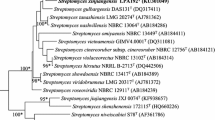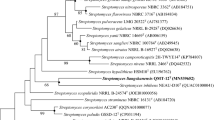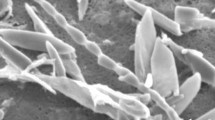Abstract
A novel actinomycete strain, GW25-5T, was isolated from a soil sample collected from the Fildes Peninsula, King George Island, West Antarctica. The strain was characterized by white to grey aerial mycelia, which were differentiated to straight to flexuous spore chains, with rod-shaped smooth spores. The cell wall of strain GW25-5T contained LL-diaminopimelic acid (A2pm) and traces of meso-A2pm. Whole-cell sugars were galactose and minor amounts of mannose and glucose. The predominant menaquinones were MK-9(H6) (49%), MK-9(H8) (24%) and MK-9(H4) (12%). The phospholipids contained DPG, PE, PI, PIM and PL(s). The major cellular fatty acids were iso-C16:0 and anteiso-C15:0. Genomic DNA G+C content of strain GW25-5T was 70.0 mol%. BLAST result showed that strain GW25-5 has the 16S rRNA gene sequence highest similarity of 97.5% with members of genus Streptomyces and phylogenetic analysis indicated that this strain belongs to the genus Streptomyces. DNA–DNA relatedness values of strain GW25-5T with the closest species of Streptomyces purpureus LMG 19368T and Streptomyces beijiangensis YIM 6T were significantly lower than 70% of the threshold value for the delineation of genomic species. A polyphasic taxonomic investigation based on a judicious combination of genotypic and phenotypic characteristics revealed that the organism represents a novel species of the genus Streptomyces. Thus, we propose strain GW25-5T as the type strain of this novel species, Streptomyces fildesensis (=CGMCC 4.5735T = YIM 93602T = DSM 41987T = NRRL B 24828T).
Similar content being viewed by others
Avoid common mistakes on your manuscript.
Introduction
The genus Streptomyces was first described by Waksman and Henrici (1943) and as of now, contained over five hundred validly published species (588) plus subspecies (38) (Euzéby 2011; http://www.bacterio.cict.fr/s/streptomycesa.html). Members of this genus are well known for their ability to produce antibiotics, enzymes, enzyme inhibitors and pharmacologically active agents (Bérdy 2005; Chun et al. 1997; Labeda et al. 1997). In the course of a screening program for new cytotoxic antibiotics, one streptomycete strain GW25-5T was isolated from a soil sample collected from the west coast of the Fildes Peninsula near the Chinese Antarctic Great Wall Station, King George Island, West Antarctica. Based on phenotypic and genotypic evidence, it is proposed that this isolate represents a novel species of the genus Streptomyces, for which the name Streptomyces fildesensis sp. nov., is proposed.
Materials and methods
Strains and culture conditions
Strain GW25-5T, was isolated on inorganic salts-starch agar [International Streptomyces project (ISP) medium 4 (Shirling and Gottlieb 1966)] after incubation at 28°C for 2 weeks. The purified strain was maintained on ISP medium 2 (Shirling and Gottlieb 1966) slants at 4°C and as 20% (v/v) glycerol suspensions at −80°C. Strain GW25-5T was deposited in the China General Microbiological Culture Collection Center (CGMCC) as strain CGMCC 4.5735T and in the German Collection of Microorganisms and Cell Cultures (DSMZ) as strain DSM 41987T.
Biomass for chemical and molecular studies was obtained by cultivation in shaken flasks (about 200 rpm) using ISP medium 2 at 28°C for 1 week.
Phenotypic characteristics
Morphological, cultural, physiological and biochemical characterizations of strain GW25-5T were studied by following the guidelines of the International Streptomyces project (Shirling and Gottlieb 1966, 1968a, 1968b). The morphological characteristics of strain GW25-5T, including spore-chain morphology, spore size and surface ornamentation, were assessed by light microscopy (Olympus microscope BH-2) and scanning electron microscopy (JSM5600LV; JEOL) of 14-day-old cultures on ISP medium 2. Aerial spore-mass colour, substrate mycelium pigmentation and coloration of the diffusible pigments of strain GW25-5T were recorded on ISP media, Czapek’s agar, potato–glucose agar and nutrient agar prepared as described by Dong and Cai (2001). Colour determination was compared with colour chips from the ISCC-NBS COLOUR CHARTS standard sample No.2106 (Kelly 1964). This organism was examined for physiological and biochemical characteristics according to previously described methods (Shirling and Gottlieb 1966; Williams et al. 1983). Growth at different temperatures (4, 10, 20, 28, 37, 42, 45, 50 and 55°C), various pH values (4.0–10.0 at intervals of 1.0 pH unit; using the buffer system described by Xu et al. 2005) and NaCl concentrations [0, 1, 2, 3, 4, 5, 6, 7, 10, 15 and 20 (w/v)] were determined by using ISP 2 agar plates, incubation at 28°C for 14–21 days. Media and procedures used for the determination of other physiological characteristics, carbon source utilization and acid production from carbohydrates were those described by Gordon et al. (1974). Resistance to antibiotics was examined as described by Al-Tai et al. (1999).
Chemotaxonomy
Biomass for chemotaxonomy studies was obtained by cultivation in shaken flasks (200 rpm) using ISP medium 2 at 28°C for 1 week. Amino acid and sugar analysis of cell walls were carried out according to the procedures described by Hasegawa et al. (1983). Phospholipids were extracted, isolated by two dimensional TLC and identified by using previously described methods (Minnikin et al. 1984). Menaquinones were isolated according to the method of Minnikin et al. (1984) and separated by HPLC (Kroppenstedt 1982). Cellular fatty acids were extracted, methylated and analysed by using the Sherlock Microbial Identification System (MIDI) according to the manufacturer’s instructions. The fatty acid methyl esters were analysed by using the Microbial Identification software package (Sherlock Version 4.0; MIDI database: TSBA40). The G+C content of the genomic DNA was determined by using the HPLC method (Mesbah et al. 1989) with E. coli JM-109 as the reference strain.
Molecular analysis
Extraction of genomic DNA and amplification of the 16S rRNA gene sequences were performed as described by Li et al. (2007). The 16S rRNA gene sequence of strain GW25-5T was compared against a database of cultured species via BLAST analysis (http://blast.ncbi.nlm.nih.gov/Blast.cgi) and the EzTaxon Database (http://www.eztaxon.org, Chun et al. 2007) of type strains to retrieve most similar sequences of recognized bacteria. Multiple alignments with sequences of the most closely related Streptomycetes and calculations of levels of sequence similarity were carried out using CLUSTAL_X (Thompson et al. 1997). Phylogenetic analyses were performed using the PHYLIP version 3.6 (Felsenstein 2002) and MEGA version 4.1 (Tamura et al. 2007). Bootstrap analysis was used to evaluate the tree topology of the neighbour-joining data by performing 1000 resamplings (Felsenstein 1985).
DNA–DNA hybridization studies between strain GW25-5T and the closest neighbours were performed using the thermal renaturation method (De Ley et al. 1970; Huss et al. 1983; Jahnke 1992).
The 16S rRNA gene sequence of strain GW25-5T has been deposited in GenBank under the accession number DQ408297.
Results and discussion
The cells of strain GW25-5T were Gram-positive, aerobic and non-motile. Morphological features were observed on different ISP media and other related media after incubation for 2 weeks at 28°C. Strain GW25-5T grew well on yeast extract–malt extract agar (ISP 2), oatmeal agar (ISP 3), inorganic salts–starch agar (ISP 4), glycerol–asparagine agar (ISP 5) and potato agar (Table 1). It showed moderate growth on nutrient agar and Czapek’s agar medium. A dark yellow–green diffusible pigment was produced on potato agar. Strain GW25-5T had typical characteristics of the genus Streptomyces. Morphological observation of the 14-day-old culture of strain GW25-5T revealed that the aerial mycelia formed long, straight to flexuous spore chains and the spores were non-motile (Fig. 1). The physiological features are indicated in Table 2 and in the species description.
The cell wall of strain GW25-5T contained LL-diaminopimelic acid (A2pm) and trace amounts of meso-A2pm. Whole-cell hydrolysates contained galactose and small quantities of mannose and glucose. The menaquinones were MK-9(H6) (49%), MK-9(H8) (24%), MK-9(H4) (12%), MK-8(H6) (6%), MK-9(H2) (4%) and MK-8(H8) (4%). The phospholipid composition was diphosphatidylglycerol (DPG), phosphatidylethanolamine (PE), phosphatidylinositol (PI), phosphatidylinositol mannoside (PIM) and other unidentified phospholipids (PLs). The major cellular fatty acids were iso-C16:0 (30.08%), anteiso-C15:0 (23.66%), C15:0 (3.75%), anteiso-C17:0 (10.25%), anteiso-C17:1 (3.95%), iso-C16:1 (3.71%) and iso-C14:0 (6.98%). The G+C content of the genomic DNA from strain GW25-5T was 70.0 mol %, which is in accordance with the values for the genus Streptomyces (69 to 76 mol %). The chemotaxonomic characteristics of strain GW25-5T, such as amino acid and sugar of whole-cell hydrolysates, menaquinones, major fatty acids and phospholipids were consistent with its assignment to the genus Streptomyces.
The almost complete 16S rRNA gene sequence (1,44 nts) of strain GW25-5T was aligned with the corresponding sequences of representative members of the genus Streptomyces using BLAST (Altschul et al. 1997), and the results revealed the highest similarity under 97.5% with Streptomyces caeruleus NRBC12804, Streptomyces purpureus LMG 19368T, Streptomyces beijiangensis YIM 6T and Streptomyces candidus NRRL ISP-5141T. Streptomyces caeruleus, however, was reclassified as Actinoalloteichus cyanogriseus (Tamura et al. 2008). Phylogenetic analyses based on 16S rRNA gene sequences showed that strain GW25-5T fell into one distinct subclade with S. purpureus LMG 19368T and S. beijiangensis YIM 6T and was loosely associated with S. candidus NRRL ISP-5141T. The phylogenetic tree reconstructed based on the 16S rRNA gene sequences of strain GW25-5T and most closely related members of the genus Streptomyces is shown in Fig. 2.
Phylogenetic relationships of strain GW25-5T and other closely related Streptomyces species based on 16S rRNA gene sequences. The branching pattern was generated by the neighbour-joining method. Asterisks indicate branches that were also recovered using the maximum-parsimony method. Bootstrap values (expressed as percentages of 1000 replications) of above 50% are shown at branch points. Bar, 0.002 substitutions per nucleotide position
The DNA–DNA relatedness values of strain GW25-5T with S. purpureus LMG 19368T and S. beijiangensis YIM 6T were 53.8 ± 2.0 and 47.2 ± 2.0%, respectively, and both values were significantly lower than 70% of the threshold value for the delineation of genomic species (Stackebrandt and Goebel 1994) suggesting that the strain GW25-5T should be considered as a different genomic species of the genus Streptomyces. in Addition, phenotypic and physiological characteristics showed great differences between strain GW25-5T and its closest neighbours (Table 2). Thus, on the basis of polyphasic taxonomic evidence, it is suggested that strain GW25-5T represents a novel species of the genus Streptomyces, for which the name Streptomyces fildesensis sp. nov. is proposed.
Description of Streptomyces fildesensis sp. nov
Streptomyces fildesensis [fil.de.sen’sis. N.L. masc.adj. fildesensis pertaining to the Fildes Peninsula (King George Island, West Antarctica), from where the type strain was isolated].
Aerial mycelium and substrate mycelium are well developed on most media. Aerial mycelium in maturity forms long and straight to flexuous spore chains. A yellow–green diffusible pigment is produced on potato agar. Optimal growth was observed at 28°C and at pH 7.0 and in the absence of salt. Temperature, pH and NaCl tolerance ranges are 10–37°C, pH 6.0–9.0 and 0–3% (w/v), respectively. Galactose, arabinose, maltose, xylose, glycerol, sorbitol, sodium oxalate and sodium citrate are utilized as sole carbon sources for growth, but not glucose, fructose, sucrose, lactose, mannose, trehalose, ribose, cellobiose or raffinose. Melanin production and degradation of Tween 20, 40 and 60 are positive. Starch hydrolysis and urea utilization are negative. The organism is sensitive to erythromycin (15 μg/disk), gentamicin (10 μg/disk), vancomycin (30 μg/disk), lincomycin (2 μg/disk), chloramphenicol (30 μg/disk), netilmicin (30 μg/disk) and neomycin (10 μg/disk). Whole-cell hydrolysates contain galactose and trace amounts of mannose and glucose. The predominant menaquinones are MK-9(H6), MK-9(H8) and MK-9(H4). The phospholipid composition is DPG, PE, PI, PIM and PL(s). The major cellular fatty acids are iso-C16:0, anteiso-C15:0, C15:0, anteiso-C17:0, anteiso-C17:1, iso-C16:1 and iso-C14:0. The G+C content of the genomic DNA is 70.0 mol%.
The type strain, GW25-5T = CGMCC 4.5735T = YIM 93602T = DSM 41987T = NRRL B 24828T, was isolated from a soil sample collected from the west coast of Fildes Peninsula, near the Chinese Antarctic Great Wall Station, King George Island, West Antarctica.
References
Al-Tai A, Kim B, Kim SB, Manfio GP, Goodfellow M (1999) Streptomyces malaysiensis sp. nov., a new streptomycete species with rugose, ornamented spores. Int J Syst Bacteriol 49:1395–1402
Altschul SF, Madden TL, Schaffer AA, Zhang J, Zhang Z, Miller W, Lipman DJ (1997) Gapped BLAST and PSI_BLAST: a new generation of protein database search programs. Nucleic Acids Res 25:3389–3402
Bérdy J (2005) Bioactive microbial metabolites. J Antibiot (Tokyo) 58:1–26
Chun J, Youn HD, Yim YI, Lee H, Kim MY, Hah YC, Kang SO (1997) Streptomyces seoulensis sp. nov. Int J Syst Bacteriol 47:492–498
Chun J, Lee JH, Jung Y, Kim M, Kim S, Kim BK, Lim YW (2007) EzTaxon: a web-based tool for the identification of prokaryotes based on 16S ribosomal RNA gene sequence. Int J Syst Evol Microbiol 57:2259–2261
De Ley J, Cattoir H, Reynaerts A (1970) The quantitative measurement of DNA hybridization from renaturation rates. Eur J Biochem 12:133–142
Dong XZ, Cai MY (2001) Manual of systematics and identification of general bacteria. Science Press, Beijing
Euzéby J (2011) List of prokaryotic names with standing in nomenclature. http://www.bacterio.cict.fr/s/streptomycesa.html
Felsenstein J (1985) Confidence limits on phylogenies: an approach using the bootstrap. Evolution 39:783–791
Felsenstein J (2002) PHYLIP (phylogeny inference package), version 3.6a. Distributed by the author. Department of Genome Science. University of Washington, Seattle
Gordon RE, Barnett DA, Handerhan JE, Pang CHN (1974) Nocardia coeliaca, Nocardia autotrophica, and the nocardin strain. Int J Syst Bacteriol 24:54–63
Hasegawa T, Takizawa M, Tanida S (1983) A rapid analysis for chemical grouping of aerobic actinomycetes. J Gen Appl Microbiol 29:319–332
Huss VAR, Festl H, Schleifer KH (1983) Studies on the spectrophotometric determination of DNA hybridization from renaturation rates. Syst Appl Microbiol 4:184–192
Jahnke KD (1992) BASIC computer program for evaluation of spectroscopic DNA renaturation data from Gilford System 2600 spectrophotometer on a PC/XT/AT type personal computer. J Microbiol Methods 15:61–73
Kelly KL (1964) Inter-society color council–National bureau of standard color-name charts illustrated with centroid colors. US Government Printing Office, Washington
Kroppenstedt RM (1982) Separation of bacterial menaquinones by HPLC using reverse phase (RP 18) and a silver loaded ion exchanger as stationary phases. J Liq Chromatogr 5:2359–2387
Labeda DP, Lechevalier MP, Testa RT (1997) Streptomyces stramineus sp. nov., a new species of the verticillate streptomycetes. Int J Syst Bacteriol 47:747–753
Li WJ, Xu P, Schumann P, Zhang YQ, Pukall R, Xu LH, Stackebrandt E, Jiang CL (2007) Georgenia ruanii sp. nov., a novel actinobacterium isolated from forest soil in Yunnan (China) and emended description of the genus Georgenia. Int J Syst Evol Microbiol 57:1424–1428
Mesbah M, Premachandran U, Whitman WB (1989) Precise measurement of the G+C content of deoxyribonucleic acid by high-performance liquid chromatography. Int J Syst Bacteriol 39:159–167
Minnikin DE, O’Donnell AG, Goodfellow M, Alderson G, Athalye M, Schaal A, Parlett JH (1984) An integrated procedure for the extraction of isoprenoid quinones and polar-lipids. J Microbiol Methods 2:233–241
Shirling EB, Gottlieb D (1966) Methods for characterization of Streptomyces species. Int J Syst Bacteriol 16:313–340
Shirling EB, Gottlieb D (1968a) Cooperative description of type cultures of Streptomyces. II. Species descriptions from first study. Int J Syst Bacteriol 18:69–189
Shirling EB, Gottlieb D (1968b) Cooperative description of type cultures of Streptomyces. III. Additional species descriptions from first and second studies. Int J Syst Bacteriol 18:279–392
Stackebrandt E, Goebel BM (1994) Taxonomic note: a place for DNA–DNA reassociation and 16S rRNA sequence analysis in the present species definition in bacteriology. Int J Syst Bacteriol 44:846–849
Tamura K, Dudley J, Nei M, Kumar S (2007) MEGA4: molecular evolutionary genetics analysis (MEGA) software version 4.0. Mol Biol Evol 24:1596–1599
Tamura T, Ishida Y, Otoguro M, Hatano K, Labeda D, Price NP, Suzuki KI (2008) Reclassification of Streptomyces caeruleus as a synonym of Actinoalloteichus cyanogriseus and reclassification of Streptomyces spheroides and Streptomyces laceyi as later synonyms of Streptomyces niveus. Int J Syst Bacteriol 58:2812–2814
Thompson JD, Gibson TJ, Plewniak F, Jeanmougin F, Higgins DG (1997) The CLUSTAL_X windows interface: flexible strategies for multiple sequence alignment aided by quality analysis tools. Nucleic Acids Res 25:4876–4888
Waksman SA, Henrici AT (1943) The nomenclature and classification of the actinomycetes. J Bacteriol 46:337–341
Williams ST, Goodfellow M, Alderson G, Wellington EMH, Sneath PHA, Sackin MJ (1983) Numerical classification of Streptomyces and related genera. J Gen Microbiol 129:1743–1813
Xu P, Li WJ, Tang SK, Zhang YQ, Chen GZ, Chen HH, Xu LH, Jiang CL (2005) Naxibacter alkalitolerans gen. nov., sp. nov., a novel member of the family ‘Oxalobacteraceae’ isolated from China. Int J Syst Evol Microbiol 55:1149–1153
Acknowledgments
This research was supported by the National Basic Research Program of China (No. 2010CB833801), The National Natural Science Foundation of China (40906075, 40906076), Shandong Provincial Science and Technology Development Program (project no.2009GG10002082), State Key Laboratory of Microbial Resources, Institute of Microbiology, Chinese Academy of Sciences (SKLMR-080601) and the SOA Key Laboratory for Polar Science (KP2005013). The authors acknowledge the support of Chinese Arctic and Antarctic Administration of the State Oceanic Administration.
Author information
Authors and Affiliations
Corresponding authors
Additional information
Electronic supplementary material
Below is the link to the electronic supplementary material.
Rights and permissions
About this article
Cite this article
Li, J., Tian, XP., Zhu, TJ. et al. Streptomyces fildesensis sp. nov., a novel streptomycete isolated from Antarctic soil. Antonie van Leeuwenhoek 100, 537–543 (2011). https://doi.org/10.1007/s10482-011-9609-7
Received:
Accepted:
Published:
Issue Date:
DOI: https://doi.org/10.1007/s10482-011-9609-7






